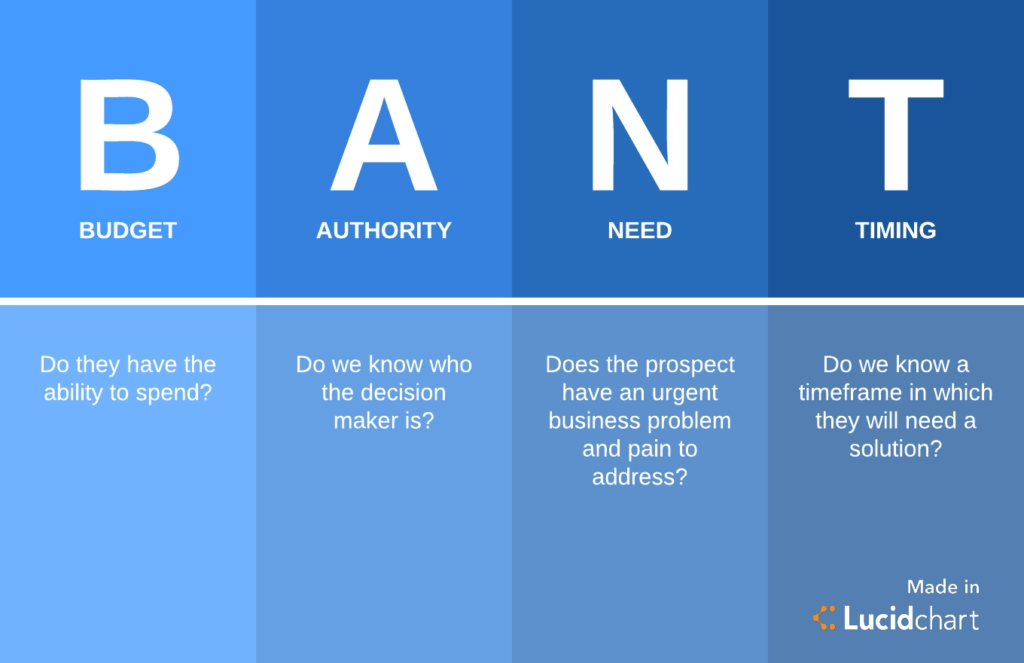
You may have the best product in the world but that never guarantees that everyone will want it. Even the best products have trouble attracting customers. Why? Because every product needs a target market; a specific persona it will resonate with. Also, every product has a season. So, you may have the right market cornered, but the seasonality of your product could make it difficult to sell sometimes more than others. This is why it’s important to qualify every lead. If you don’t, you run the risk of getting stuck in a long and frustrating sales process that may never lead to conversion. That’s where lead qualification comes in. More specifically, a qualification process called BANT. But, what is BANT?
BANT is a system that marketers can use to eliminate prospects that are less likely to convert, in favor of those that are more likely.
What is BANT?
BANT stands for Budget, Authority, Need, and Timing. They indicate the following:
- Budget: Is the prospect prepared and able to buy?
- Authority: Does the prospect have decision-making power?
- Need: Does your product address a pain point experienced by your prospect?
- Timing: Is there urgency on the prospect’s part that should cause them to buy now?
These 4 elements provide a gauge that marketers and salespeople can use to determine a prospect’s readiness to buy.
How to Use BANT: Important Lead Qualification Questions to Ask
Applying BANT requires finesse. It isn’t just a simple process of asking questions. Granted, questions are an important part of BANT as they move the conversation forward. But, asking the wrong questions, or the right questions but in the wrong manner, could stall the whole process.
To increase the possibility of best outcome, consider doing the following under each criterion:
Budget
The Budget part of BANT indicates the ability to afford a product and the willingness to spend on it. This is especially the case if your products or services are costly.
By asking budget-related questions, you hope to achieve the following:
Determine if the business has a set budget for your product
When serving B2B clients, it’s important to determine whether potential clients are prepared to buy. If they don’t, this means you will have a harder time convincing them, and a potentially longer sales cycle. Below are questions that will help you gauge your target’s suitability based on budget:
- Do you have a set budget for fixing this problem?
- How much do you spend on this problem currently?
- Which function or department is funding the system?
- How heavily does pricing affect your decision to fix the problem now?
- How much are you losing because of this problem? How does that compare to the budget that you would spend on fixing it?
- If you fix this need, you stand to make X amount of gains. How does this compare to your budget?
- If you were to build the solution by yourself, how much would that cost you?
- Assuming you don’t fix the issue, how much will it cost in the short, mid, and long term?
- What’s your expected ROI from addressing this pain point?
Authority
No matter how well-prepared you are and no matter how good your sales pitch is, it may not matter much if you aren’t pitching to the right person. So, the Authority part of BANT indicates the person with decision-making authority who needs to hear your pitch.
In most cases, C-suite executives and other senior managers may have the power to sign off on budgets, but they also rely on their subordinates for advice. Therefore, when determining authority, you should determine who is most impacted the most by the pain point. Should you encounter a situation where you have to first pitch to a person in a more subordinate position, consider how much weight that employee’s point of view carries in the final purchase decision. Here are the questions to ask to determine authority:
- Who would be the primary user of this product?
- Have you ever purchased a similar product? How was that purchase decision handled?
- I find that these decisions usually involve other stakeholders in the company. Can we ask them to sit in our next meeting to get their opinion on the issue ‘Y’ or ‘Z’?
- Can you think of anyone else we should invite?
By convincing all the immediate stakeholders, you eliminate a major obstacle in the sales process.

Source – Lucidchart
Need
You can’t sell until you establish if there is a need for your product. The Need in BANT varies in intensity, so you have to dig out such variations with the right questions, and, make sure the answers you get contain information you can work with. For instance,
Question: How long have you experienced this issue?
Answer: Oh, a few weeks…. couple of months maybe?
Such an answer shows that the prospect hasn’t felt the pain enough to want to do something about it. Ask follow-up questions in such cases, to learn more details about such a prospect’s situation and how much they need to resolve it.
In addition, it is common for companies to try to solve problems internally first before they seek outside help. If the company hasn’t tried or is in the process of trying to implement a solution internally, whatever you propose has to offer more value. Understanding a prospect’s attempts at solving a problem will also tell you the direction they may want to take next. It gives you something to compare against what you have to offer. Here are some examples of questions to assess the need for your solution:
- How long have you experienced this problem?
- How will your work be impacted if the problem isn’t solved?
- Do you consider solving the problem a priority?
- Have you tried any solutions internally?
Note that “Need” questions in BANT go beyond just qualifying prospects to actually generating interest in businesses that may not know they have a problem that could be fixed by your product. in such cases, allow the prospect to describe the problem in their own terms and sort of edge themselves towards the realization that your solution could be useful to them.
Timeline
In sales, timing is everything. Timeline-focused BANT questions determine urgency. A prospect with an urgent need will want it addressed immediately.
Some clients may actually want an immediate solution. Therefore, before you approach a prospect, you must determine whether you have the capacity to fulfill their order immediately. If the need is not urgent and the client can push their need for a solution down the line, then you have to determine whether it is worthwhile having them in your pipeline and nurture them for a future sale. You can launch a long-term campaign for client acquisition. Here are some examples of questions to assess the timeline:
- What are your goals and how does this problem affect them?
- How much will it cost you if you leave this problem unresolved this quarter?
- What is your deadline for solving this problem?
Urgency is all about showing your prospective leads that they will reap more value from buying your product in the present rather than in the future. The question about cost for instance, actually gives the prospect pause and creates urgency because no business would want to lose money. If it’s a productivity issue they are experiencing, for instance, showing them how much it costs by going unresolved is a good way to get prospects around to your way of thinking.
How to Win With BANT in 2021
Now that you know what is BANT, how can you effectively apply it to your lead qualification process in 2021?
Employ A Subtle Approach
You want information, and granted, that information will help you close a sale. But you may not get very far if you jump right in and start asking questions.
First, invest some time in building rapport and getting to know your prospective client, their company, and the challenges posed by their problem. Sometimes, you will find that by letting the prospect talk to you, he or she might actually be answering a lot of your BANT questions without you even asking them.
Demonstrate Value
Businesses invest in value. If you don’t show that your solution will add value, then you are likely to get answers such as, “We don’t have the budget,” “We aren’t looking for a solution right now,“ etc. Do the following to avoid it:
- Research beforehand so that by the time you meet your prospect, you will have a pitch that will wow them by addressing the “N” part of BANT.
- In addition, be prepared to offer flexible payment options. For instance, if a product costs $25000 annually, see if you could be flexible enough to allow them to pay monthly installments.
Switch up your approach depending on the prospect
There are different strategies for qualifying customers, and you should be open and flexible enough to switch them as needed. For instance, if you consider it better to first identify a decision maker, ANUM, a lead qualification approach that stands for authority, need, urgency, and money is more helpful. On the other hand, while the F in the FAINT approach stands for funds, it is an approach employed by salespeople interested in enterprise clients and not small businesses.
The lead qualification approach depends on the qualifying factor most suited to your company.
Conclusion
BANT isn’t the only framework for qualifying leads, but its simplicity makes it a great starting point. As you work out how to qualify sales leads in 2021, feel free to use the questions above or at least some variation of the same, with small tweaks to suit your industry or client base.
Finally, avoid these common pitfalls that could drive your potential clients away:
- Don’t be too eager to close a client. Instead, show genuine interest by treating them like real people. Practice makes perfect, so rehearse how you introduce your questions, until you get it right.
- Don’t force BANT. As mentioned, it is not the only approach. If your conversation with a client takes on another shape, weave your questions into the conversation naturally.
- Don’t ignore your CRM software. An effective sales process relies on software. Therefore, automate your software to identify opportunities and keep everything organized. Software will also help you to track performance against your business metrics.
Our blog
Latest blog posts
Tool and strategies modern teams need to help their companies grow.

Beat your competitors and exceed your revenue goals this year by shifting your focus ...

SaaS growth has never been more challenging. SaaS companies must move faster and smar...

In the absence of a solid lead scoring system, your sales team will spend time pursui...




